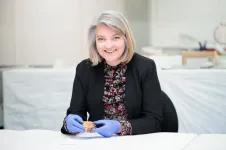Asian elephants do more than just trumpet -- they buzz their lips to squeak
The animals' sound production does not only come from the trunk
2021-06-23
(Press-News.org) Everybody from a child knows that elephants trumpet. Over the past decades research in general and at the University of Vienna has mainly studied the elephants low-frequency rumble. Its fundamental frequency reaches into the infrasonic range below the human hearing threshold. This call is produced by the elephant´s massive vocal folds. Much less was known about how elephants produce their higher pitched sounds, trumpets and squeaks.
The following rule generally applies to sound production in mammals: the larger the vocal fold, the lower the calls fundamental frequency. Conversely the size of the vocal folds sets an upper limit to the fundamental frequencies that can be reached. The high-pitched squeak only Asian but not African elephants produce when aroused, do not fit within that spectrum.
In her recent study Veronika Beeck, who is part of the FWF doctorate school Cognition and Communication at the Department of Behavioural and Cognitive Biology at the University of Vienna and her supervisor Angela Stöger, together with Gunnar Heilmann and Micheal Kerscher from gfai tech, Berlin, studied the squeak sounds of Asian elephants in Nepal.
The researchers used an acoustic camera with an array of 48 microphones that visualises sounds in colours similar to a thermic camera. In this way the sound source was precisely located. "Our images clearly demonstrate that the squeaks are emitted by the mouth and not the trunk", Veronika Beeck explains.
According to the researcher's theory the Asian elephants produce squeaks by pressing air through their tensed lips inducing the lip´s vibration. This technique equals the human brass players lip buzzing to produce a complex sound whose harmonic overtones are subsequently resonated by the instrument, resulting in its characteristic brassy sound. "Apart from human brass players this technique of lip buzzing to produce sounds has, to our knowledge, not been described in any other animal species and is thus considered unique in the animal kingdom", says Veronika Beeck.
The elephants iconic trumpet on the other hand is produced by a blast of air through the trunk. Here again, however, the vibrating anatomic sound source is not yet conclusively studied.
This new evidence further highlights the elephant´s flexibility in sound production. A few years ago, Angela Stöger-Horwath showed that elephants are capable of learning novel sounds. An Asian elephant in a Korean Zoo, by imitating his trainer, learned to speak some words in Korean. Since only a few elephants in this recent study squeaked the researchers suggest that squeaks might be learned, too.
INFORMATION:
Publication in BMC Biology:
A novel theory of Asian elephant high-frequency squeak production.
Veronika C. Beeck, Gunnar Heilmann, Michael Kerscher, Angela S. Stoeger
DOI: BMCB-D-20-01049
[Attachments] See images for this press release:

ELSE PRESS RELEASES FROM THIS DATE:
2021-06-23
University of Maryland researchers created the first high-resolution image of an expanding bubble of hot plasma and ionized gas where stars are born. Previous low-resolution images did not clearly show the bubble or reveal how it expanded into the surrounding gas.
The researchers used data collected by the Stratospheric Observatory for Infrared Astronomy (SOFIA) telescope to analyze one of the brightest, most massive star-forming regions in the Milky Way galaxy. Their analysis showed that a single, expanding bubble of warm gas surrounds the Westerlund 2 star cluster and disproved earlier studies suggesting there may be two bubbles surrounding Westerlund 2. The researchers also identified the source of the bubble ...
2021-06-23
In the United States, more than 12 million children hear a minority language at home from birth. More than two-thirds hear English as well, and they reach school age with varying levels of proficiency in two languages. Parents and teachers often worry that acquiring Spanish will interfere with children's acquisition of English.
A first-of-its kind study in U.S.-born children from Spanish-speaking families led by researchers at Florida Atlantic University finds that minority language exposure does not threaten the acquisition of English by children in the U.S. and that there is no trade-off ...
2021-06-23
CHAMPAIGN, Ill. -- Nineteenth- and 20th-century archaeologists often made sweeping claims about Native cultures, suggesting that everyone who lived in a particular region at a given time shared the same attitudes and practices. A new study of pipes recovered from Hopewell sites in Illinois and Ohio challenges this assumption, revealing that the manufacture, import, export and use of pipestone pipes for smoking varied significantly between the groups, even though they engaged in trade with one another.
The Hopewell era ran from about 50 B.C. to A.D. 250. The new findings are reported in the journal American Antiquity.
The Havana and Scioto Hopewell people, who lived in what is now Illinois ...
2021-06-23
A Canadian research team has uncovered a new mechanism involved in Bourneville tuberous sclerosis (BTS), a genetic disease of childhood. The team hypothesizes that a mutation in the TSC1 gene causes neurodevelopmental disorders that develop in conjunction with the disease.
Seen in one in 6,000 children, tuberous sclerosis causes benign tumours or lesions that can affect various organs such as the brain, kidneys, eyes, heart and skin. While some patients lead healthy lives, others have significant comorbidities, such as epilepsy, autism and learning disabilities.
Although the role that the TSC1 gene plays in the disease is already known, Montreal scientists have only now identified a critical period in the postnatal development ...
2021-06-23
When a pregnant person declines a recommended treatment such as prenatal testing or an epidural, tension and strife may ensue between the patient and provider, according to a new analysis by researchers at NYU Rory Meyers College of Nursing and the University of British Columbia.
"People should feel safe, respected, and engaged in their maternity care, but our findings suggest that when providers do not listen to patients, it can foster mistrust and avoidance," said P. Mimi Niles, PhD, MPH, CNM, assistant professor at NYU Rory Meyers College of Nursing and the lead author of the study, which is published in the journal PLOS ONE. ...
2021-06-23
Middle school, a time when children's brains are undergoing significant development, is often also a time of new challenges in navigating the social world. Recent research from the Center for BrainHealth at UT Dallas demonstrates the power of combining a virtual platform with live coaching to help students enhance their social skills and confidence in a low-risk environment.
In this study, BrainHealth researchers partnered with low-income public middle schools in Dallas. Teachers recommended 90 students to participate in virtual training sessions via ...
2021-06-23
Epstein-Barr virus (EBV) reactivation resulting from the inflammatory response to coronavirus infection may be the cause of previously unexplained long COVID symptoms -- such as fatigue, brain fog, and rashes -- that occur in approximately 30% of patients after recovery from initial COVID-19 infection. The first evidence linking EBV reactivation to long COVID, as well as an analysis of long COVID prevalence, is outlined in a new long COVID study published in the journal Pathogens.
"We ran EBV antibody tests on recovered COVID-19 patients, comparing EBV reactivation rates of those with long COVID symptoms to those without ...
2021-06-23
Niigata, Japan - An estimated 1.13 billion people worldwide have hypertension or high blood pressure, and two-thirds of these individuals are living in low- and middle-income countries. Blood pressure is the force manifested by circulating blood against the walls of the body's arteries, the major blood vessels in the body. Hypertension is when blood pressure is too high.
Blood pressure is written as two numbers. The first (systolic) number represents the pressure in blood vessels when the heart contracts or beats. The second (diastolic) number represents the pressure in the vessels when the heart rests between beats. Hypertension is diagnosed if, when it is measured on two different days, the systolic blood pressure (SBP) readings on both days is ≥140 mmHg and/or the diastolic ...
2021-06-23
Supercomputers could find themselves out of a job thanks to a suite of new machine learning models that produce rapid, accurate results using a normal laptop.
Researchers at the ARC Centre of Excellence in Exciton Science, based at RMIT University, have written a program that predicts the band gap of materials, including for solar energy applications, via freely available and easy-to-use software. Band gap is a crucial indication of how efficient a material will be when designing new solar cells.
Band gap predictions involve quantum and atomic-scale chemical calculations ...
2021-06-23
It's one of the iconic images of early Antarctic exploration: the heroic explorer sledging across the icy wastes towed by his trusty team of canine companions.
But new research analysing a century-old dog biscuit suggests the animals in this picture were probably marching on half-empty stomachs: early British Antarctic expeditions underfed their dogs.
In a paper just published in Polar Record, researchers from Canterbury Museum, Lincoln University and University of Otago in New Zealand analysed the history and contents of Spratt's dog cakes, the chow of choice for the canine members of early Antarctic expeditions.
Lead author, ...
LAST 30 PRESS RELEASES:
[Press-News.org] Asian elephants do more than just trumpet -- they buzz their lips to squeak
The animals' sound production does not only come from the trunk






